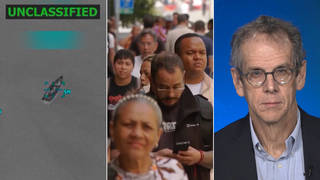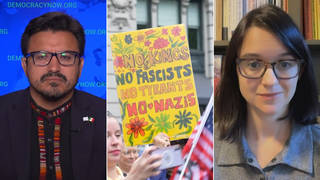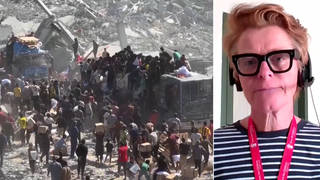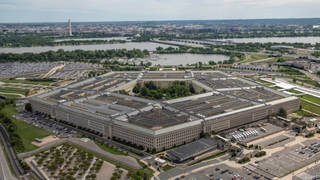
By Amy Goodman with Denis Moynihan
Seventy-five years ago, the Spanish town of Guernica was bombed into rubble. The brutal act propelled one of the world’s greatest artists into a three-week painting frenzy. Pablo Picasso’s “Guernica” starkly depicts the horrors of war, etched into the faces of the people and the animals on the 20-by-30-foot canvas. It would not prove to be the worst attack during the Spanish Civil War, but it became the most famous, through the power of art. The impact of the thousands of bombs dropped on Guernica, of the aircraft machine guns strafing civilians trying to flee the inferno, is still felt to this day—by the elderly survivors, who will eagerly share their vivid memories, as well as by Guernica’s youth, who are struggling to forge a future for their town out of its painful history.
The German Luftwaffe’s Condor Legion did the bombing at the request of Gen. Francisco Franco, who led a military rebellion against Spain’s democratically elected government. Franco enlisted the help of Adolf Hitler and Benito Mussolini, who were eager to practice modern techniques of warfare on the defenseless citizens of Spain. The bombing of Guernica was the first complete destruction by aerial bombardment of a civilian city in European history. While homes and shops were destroyed, several arms-manufacturing facilities, along with a key bridge and the rail line, were left intact.
Spry and alert at 89, Luis Iriondo Aurtenetxea sat down with me in the offices of Gernika Gogoratuz, which means “Remembering Gernika” in the Basque language. Basque is an ancient language and is central to the fierce independence of Basque-speaking people, who have lived for millennia in the region that straddles the border of Spain and France.
Luis was 14 and working as an assistant at a local bank when Guernica was bombed. It was market day, so the town was full, the market square packed with people and animals. The bombing started at 4:30 p.m. on April 26, 1937. Luis recalled: “It went on and on for three and a half hours. When the bombing ended, I left the shelter and I saw all of the town burning. Everything was on fire.”
Luis and others fled uphill to the nearby village of Lumo, where, as night fell, they saw their hometown burning, saw their homes collapse in the flames. They were given space to sleep in a barn. Luis continued: “I don’t remember if it was at midnight or at another time, as I did not own a watch at the time. I heard someone calling me. … In the background, you could see Guernica on fire, and thanks to the light of the fire, I realized that it was my mother. She had found my other three siblings. I was the last one to be found.” Luis and his family were war refugees for many years, eventually returning to Guernica, where he still lives and works—as did Picasso in Paris — as a painter.
Luis took me to his studio, its walls covered with paintings. Most prominent was the one he painted of that moment in Lumo when his mother found him. I asked him how he felt at that moment. His eyes welled. He apologized and said he couldn’t speak of it. Just blocks away stands one of the arms factories that avoided destruction. It was the plant where chemical weapons and pistols were made. It is called the Astra building. While Astra has moved away, the weapons company maintains its connection to the town by naming is various automatic weapons the “Guernica,” designed “by warriors, for warriors.”
Several years ago, young people occupied the vacant plant, demanding it be turned into a cultural center. Oier Plaza is a young activist from Guernica who told me, “At first the police threw us out, and then we occupied it again, and finally, the town hall bought the building, then we started this process to recover the building and to create the Astra project.”
The aim of the Astra project is to convert this weapons plant into a cultural center with classes in art, video and other media production. “We have to look to the past to understand the present, to create a better future, and I think Astra is part of that process. It is the past, it is the present, and it is the future of this town.”
From Picasso’s “Guernica” to Luis Iriondo Aurtenetxea’s self-portrait with his mother, to the efforts of Oier Plaza and his young friends, the power of art to turn swords into plowshares, to resist war, is perennially renewed.
Amy Goodman is the host of “Democracy Now!,” a daily international TV/radio news hour airing on more than 1,000 stations in the U.S. and around the world. She is the author of “Breaking the Sound Barrier,” recently released in paperback and now a New York Times best-seller.
© 2012 Amy Goodman











Media Options